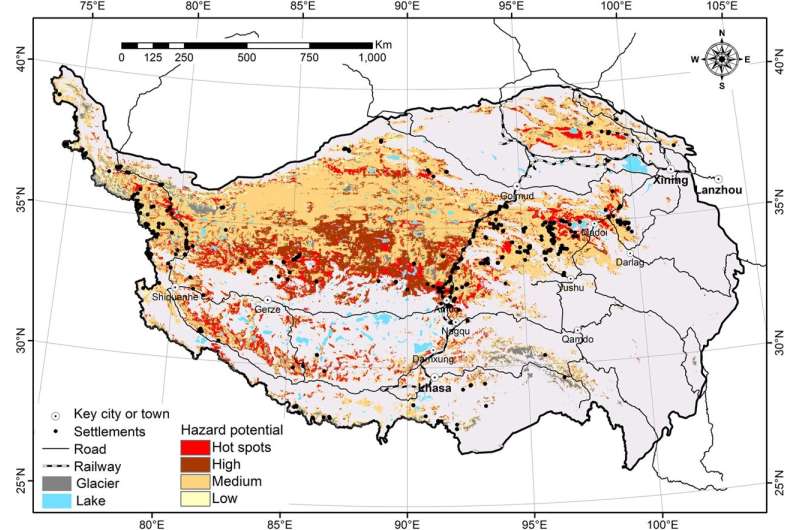Permafrost degradation increases future costs of infrastructure on Qinghai-Tibet Plateau

Depending on altitude, the warming rate of the Qinghai-Tibet Plateau (QTP) has been twice the global average in recent decades. Climate change-induced permafrost degradation can seriously threaten the stability of the infrastructure and thus increase infrastructure repair and replacement frequency.
Integrating data-driven projection, multi-hazard index, and lifespan replacement models, researchers from the Northwest Institute of Eco-Environment and Resources of the Chinese Academy of Sciences (CAS) have evaluated the economic damage of permafrost degradation on the infrastructure over the QTP for the first time. Their results were published in Communications Earth & Environment on Oct. 13.
According to the researchers, 38% of roads, 39% of railways and power lines, and 21% of buildings may be threatened by permafrost degradation in high-hazard areas (SSP245) by 2050. These proportions may nearly double by the end of this century.
Correspondingly, the additional cost of $4 billion (net present value, 2.85% annual discount rate) by 2050 and approximately $6.3 billion by the end of this century will be needed to maintain the service function of current infrastructure under the historical scenario (SSP245).
Under the green scenario (SSP126), an additional cost of $3.6 billion will be required by 2050, which is a substantial reduction compared to the results under SSP245. This reduction could further increase to $1.6 billion by the end of this century.
The global climate warming goals of the Paris Agreement could have considerably different influences on hazard levels by the end of this century. Controlling global warming below 1.5 °C may reduce the infrastructure in high-hazard zones by approximately half and reduce the costs by $1.3 billion compared to the results under the 2 °C target.
The adaptation measures for high-grade roads, railways, power lines and buildings would greatly reduce this additional cost. By 2050, the percentage of potential cost savings from adaptations is approximately 15% (SSP245). This savings could reach 21% by the end of the century.
More information: Youhua Ran et al, Permafrost degradation increases risk and large future costs of infrastructure on the Third Pole, Communications Earth & Environment (2022). DOI: 10.1038/s43247-022-00568-6
Journal information: Communications Earth & Environment
Provided by Chinese Academy of Sciences



















